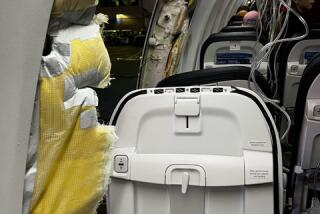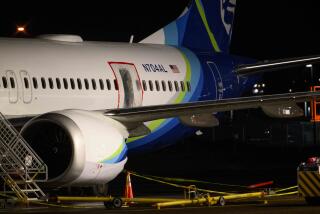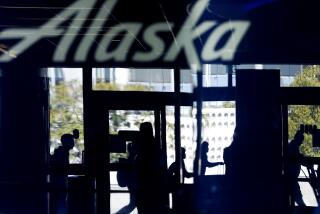Airbus A380 arrives in Sydney two years behind schedule

Nearly a decade in the making and two years late, the world’s largest passenger jet made its commercial debut today with a flight from Singapore to Sydney that carried more than 400 people, some of them wearing T-shirts that said, “I did it on the A380.”
For Boeing Co., it was the gauntlet. The flight of the double-decker Airbus Megaliner kicked off the latest round in the do-or-die contest between the aerospace rivals to determine how long-distance travelers will fly.
European aircraft maker Airbus has bet the farm on the massive A380, convinced that as major airports around the world become more congested, the answer for airlines will be a super-plane that can do the job of three Boeing-sized jets.
Chicago-based Boeing has put its money on the relatively petite 787 Dreamliner, believing that airlines will increasingly opt to avoid the likes of Los Angeles International Airport and lease more gates at smaller facilities like those in Burbank and Long Beach.
“They have a different view of the world,” said Richard Aboulafia, an aerospace analyst with Teal Group Corp. “We’ll see who’s right.”
For Kris Trexler, a film editor from Los Angeles who boarded the A380 in Singapore with a high-definition video camera, there was no question as to the answer.
“This is aviation history,” said Trexler, filming flight attendants pouring Dom Perignon champagne. “This is the best, most exciting flight of my life, and I’ve been on a lot.”
Some of Trexler’s fellow passengers paid handsomely to make such history on Singapore Airlines Flight 380. The carrier auctioned tickets on EBay, drawing bids from all over the world. A Sydney businessman paid $100,380 for two spaces in one of 12 luxury private suites equipped with seats as well as full-size beds, with the money going to charities in Australia and Singapore.
Trexler won his place in coach with a bid of $1,025. When the Megaliner begins regular daily flights Sunday, a one-way economy fare is expected to cost about $600.
Any price would have been a bargain for Trexler, who works on the sitcom “According to Jim.” The night before takeoff, he couldn’t sleep, he said. “This is as close to a memory of a lifetime as it’ll get.”
Last week, when Singapore Airlines Chief Executive Chew Choon Seng took delivery of the A380, he called it “the new queen of the skies.”
But at this point in the race, Boeing is ahead. It has sold more than 700 Dreamliners -- the first 787 will go into commercial service late next year -- while Airbus has orders for 165 Megaliners.
Airbus officials said they were expecting a second wave of orders with the start of regular commercial flights. Those will be mostly in Asia and Europe at first. Late next year, though, Qantas Airways will probably make its inaugural A380 trip to LAX from Australia.
If the A380 performs well in regularly scheduled flights, “it has a chance,” said Adam Pilarski, senior vice president of the aviation research firm Avitas Inc. “It’s a big plane, but how many people are on a cruise ship? Not many people complain about that.”
In fact, Pilarski said he didn’t think the Megaliner was big enough, despite the fact that a football field could fit across its wingspan.
Right now, he said, “it doesn’t have substantial advantage over the 747, but it will when it is stretched. When it carries 900 people it will be great.”
On today’s flight, there were 468 passengers -- 75 of them newspaper and television reporters.
“I expected it to have a party atmosphere, but I didn’t expect all the media. It’s become a media circus,” said Dean Wood, a Miami resident who paid $15,000 for business-class seats for himself and his wife, Stephanie Mogol-Wood, a Calabasas native.
The couple estimated they had been interviewed 20 times by reporters from all over the world. “The biggest question was how much did you pay,” Wood said. “I tried to be vague.”
Passengers snapped pictures of one another in various areas of the plane, including the spiral staircase in the rear, and even in the bathrooms, some of which could fit several people at a time.
“It’s like a freak show,” said Anthony MacKay, an Australian living in London who paid $12,500 for two seats in business class. “I wonder what it will be like a month from now.”
Thomas Lee, who 37 years ago flew on the inaugural flight of the 747, said people back then were far more subdued, though that may have been because the first 747 developed engine trouble and the flight took place on a substitute jet.
Lee said the A380 ride seemed smoother than the 747. “I was surprised by how quiet it is,” he said.
As the plane landed, passengers on the main deck let out a loud cheer after a passenger yelled that the cabin crew should get some appreciation for putting up with all chaos.
For Singapore Airlines, the decision to fly the A380 on the Singapore-Sydney route was strategic.
The airline has been in a bitter battle with rivals British Airways and Qantas to fly the lucrative route that connects travelers from Europe and Australia. Before jets, propeller planes from Europe had to make numerous stopovers to reach Australia. Because of the “hops” involved, the trip became known as the Kangaroo Route.
These days, a flight from London typically stops over in Singapore before proceeding to Australia, and vice versa. Singapore Airlines hope the introduction of the A380 will help it lure passengers, particularly first- and business-class customers, away from its competitors.
More to Read
Sign up for The Wild
We’ll help you find the best places to hike, bike and run, as well as the perfect silent spots for meditation and yoga.
You may occasionally receive promotional content from the Los Angeles Times.






